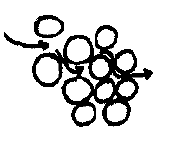BACKGROUND:
Ground water is water stored under the
surface of the Earth. Convey to the students that ground water sometimes takes
hundreds of years to accumulate. A good example of this occurs in the Sahara
Desert in Africa, where ground water has accumulated for thousands of years
and is still being used for drinking and irrigation. Ground water is stored in
the ground below us, where different types of rocks can act as reservoirs.
Sand or sandstone is the best material for a reservoir and forms extensive
aquifers underground, but not all sands are created equal, as students will
find out in lab.
Filtering water through different porous
substances cleans water naturally in the ground. Substances like charcoal and
diatomite (white powder that people put in pools), help to filter small
particles that may be suspended in water.
The ground on which we live, is made up of
many layers of different types of rocks. Water can move into the tiny pores
within the rocks or soil. As they move, the different rocks can trap the
particles in the pores. Some rocks have more pores than other rocks and can
act as a reservoir of water or an aquifer. Some municipal water supplies
depend on ground water for a source of drinking water. Filtering techniques
are used in municipal water supplies. Water from a reservoir is cleaned
through a combination of filtering and chemical processes.
PROCEDURE:
- At the beginning of this
lab, review the main components of the water cycle. This lab shows
students how ground water moves through rocks that have a high porosity.
- Students will discover that large
grains allow water to move freely and also have large pore spaces (can
hold more water). You may want to use the diagram on the right to
help you illustrate this principle. Follow the directions on the student
lab sheet. Do not use plastic beakers or graduated cylinders because
the sand will scratch the plastic.
 Have the students measure and compare
their results in order to draw conclusions. Sand size and sorting of the
sand particles do have a lot to do with how water moves. You may want to
introduce the term Porosity (meaning the pore space available for liquid)
and Permeability (how freely the liquid moves through the sand). In the
diagram to the right, you can notice that water can only flow through open
space. The best aquifers have large porosities and permeability.
In poorly sorted sands, there is usually more pore space available. Have the students measure and compare
their results in order to draw conclusions. Sand size and sorting of the
sand particles do have a lot to do with how water moves. You may want to
introduce the term Porosity (meaning the pore space available for liquid)
and Permeability (how freely the liquid moves through the sand). In the
diagram to the right, you can notice that water can only flow through open
space. The best aquifers have large porosities and permeability.
In poorly sorted sands, there is usually more pore space available.
- This is just an introduction to these
concepts. You can reuse the sand even if it is wet. However you must
drain the water and if you are doing more than one lab in a row, you may
want to save dry sand for students to do the sorting of the sand.
If the sand grains are large it tends to have more porosity and permeability.
The smaller the grains of sand the less pore space allowed for the movement
of water. The small amount of sand used in this experiment may cause
differences in results. The objective is just to recognize
water movement.
- In exercise 3, students will be testing
how to filter water. The tube is just a small water bottle,
that is filled with different layers of material that will
help clean the water. You may want students to prepare this at home
and then experiment in class. You will require a lot of different
types of soil and sand if you are doing this in class. Use
different sand, rock, charcoal, or similar items that may help clean the
water. Get a plastic water bottle (small) and make 5-7 nail size
holes on the bottom of the bottle. (You may want parents to help with this
at home.)
- Have the students add one type of
material one at a time so that layers are formed. For example first add
one inch of sand then add one inch of charcoal. A funnel, if
you have one, can make this step easier, otherwise just have them use their
hands as if they were in a sand box. Make sure the materials
are dry when you are making the layers.
- Use the worksheet to record the type
of materials used to fill the bottle. Fill in the type of material
that you used for each layer and assign it a color in the legend
area. Using the colors you have indicated in the legend, have the student
color the different layers in the bottle shape to match what their bottle
actually looks like. Each student will demonstrate if their filter
can clean dirty water in class. You may want to test out the filter, by
adding dirty water and see how well your filtering tube can clean dirty
water.
|